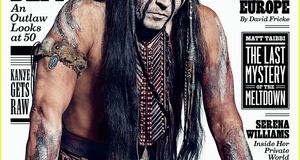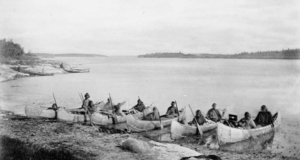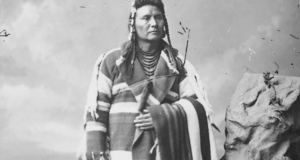Redskin and All-American: Jim Thorpe's Malleable Symbolic Significance
By
2009, Vol. 1 No. 10 | pg. 1/1
KEYWORDS:
In 1950 the Associated Press polled close to 400 sportswriters in order to name the greatest male and female athlete of the first half of the twentieth century. For the men, a crowded field of legends including Babe Ruth, Joe Louis, Jesse Owens, Red Grange, George Mikan and Bobby Jones produced a land slide winner. Jim Thorpe received more first-place votes than all of the other nominees combined. Even in 1950, more than twenty years after he retired from professional careers in football and baseball, he was widely regarded as the greatest athlete who ever lived. In the 1912 Olympics in Stockholm, where he won eight medals, two of them gold, King Gustav of Sweden shook his hand on the medal podium and said, “Sir, you are the greatest athlete in the world.” Thorpe’s response, which has been cited so often it borders on mythical, was a simple “thanks, King.”1 Jim Thorpe rose to fame on the heels of his prodigious athletic ability that translated into success in so many different sports nothing like it has not been seen since. And in the modern era of sports where athletes often specialize from an early age, it will most likely never be seen again. Thorpe, like many great athletes, rose to the public prominence because of his play on the field, but remained there because of what he represented and still represents today. He was a Native American, as current vernacular would describe him, or “redskin,” as contemporary discourse often labeled him. Within that context he was alternatively used as a symbol of the other, especially when his Carlisle Industrial School football team crushed Ivy League and West Point opponents, and as the a shining example of American democratic ideals when he achieved world-wide fame at the 1912 Olympics. Later, when he was stripped of his medals, he was once again held up as a symbol, this time as an example of an American sense of justice that would gladly sacrifice its greatest athlete in order to maintain its virtue.Thorpe’s usefulness to a society whose discourse is primarily directed by whites is not relegated to the time in which he played the games that made him famous. Mark Rubinfeld argues that Jim Thorpe is “the most recognizable Native American name of the twentieth century,” and as such his name has considerable power as symbol, both when speaking about athletics and Native American assimilation and resistance2. Thorpe the symbol has been used throughout the last century and the current one as representative of everything from America as colorblind meritocracy to America as racist devourer of its own. But before considering Thorpe the symbol, it is necessary to first have some understanding of Thorpe the athlete and Thorpe the man. Jim Thorpe was born on May 22, 1987 to Hiram and Charlotte Vieux Thorpe in what is now Oklahoma. His father was half-Irish and half Sauk and Fox, his mother was half-French and half Kickapoo-Potowatamie. As is often the case in America, Thorpe’s mixed race ancestry made him fully Indian. Thorpe was sent by his parents to a number of different schools, but he ran away from them so often that his father reportedly asked the Indian Agency to send him far enough away so that he would be unable to find his way home.3 He was eventually sent to Carlisle Industrial School, which had already gained national attention for its Indian athletes, in 1904. Shortly after he arrived, he got word that his father had died from blood poisoning, which coupled with the death of his mother in 1902, gave him no home to run to. Thorpe would eventually letter in eleven different college sports at Carlisle, and earn All-American honors in football, track, lacrosse, and basketball. Teammate Albert Exendine described him as a “strange, whimsical fellow.”4 Football was the first sport to bring him them fame he was so uncomfortable with. He began appearing in national headlines in 1908 but he became a star in 1911, earning a spot on sportswriter Walter Camp’s All-American team.5 The social significance of games against Harvard, and eventually, Army drew the attention of the national press. Here was a group of Indians playing a completely new brand of football under coach “Pop” Warner that depended on speed and misdirection (even employing the forward pass) and defeating both the intellectual elite and the future leaders of the armed forces that only a generation before were still fighting Native Americans on the Western plains. In a highly publicized game against Army in 1912 (a team that featured future President Dwight Eisenhower at half-back) the New York Times focused its coverage on Thorpe. “Standing out resplendent in a galaxy of Indian stars was Jim Thorpe,” the paper declared. “The big Indian Captain added more luster to his already brilliant record, and at times the game itself was almost forgotten while the spectators gazed on Thorpe, the individual, to wonder at his prowess. To recount his notable performances in the complete overthrow of the Cadets would leave little space for other notable points of the conflict. He simply ran wild, while the cadets tried in vain to stop his progress. It was like trying to clutch a shadow.”6 Football first brought him fame, but it was his achievements in the 1912 Olympics that made him a national hero. Thorpe became the only man to ever win gold in both the decathlon and the pentathlon, a feat which has not been replicated since. His glory was short lived, however, when questions over his playing professional baseball resulted in the forfeiting of his amateur status and his medals. Thorpe then went on to play professional baseball in 1913, and would retire in 1919. His baseball career was solid, if unspectacular; the highlight being his .327 average in his final season. His football career was more successful. He signed with the Canton Bulldogs in 1915, won three championships and in 1920 was elected president of the American Professional Football Association, the forerunner of the NFL.7 As well as being named male athlete of the century in 1950, he was also named football player of the century that same year. After his playing days, Thorpe struggled financially. He worked in Hollywood, often as an Indian extra, appearing as a terrified native in King Kong.8 In 1951, Burt Lancaster starred in a motion picture titled Jim Thorpe—All-American. Thorpe was hired on as an advisor. He died of cancer the next year. For all the acclaim Thorpe received both throughout his career and posthumously, the forfeiting of his medals remains the most significant moment of his public life, both in the intensity of media coverage of the decision and as a narrative about contemporary views of athletic glory, race, nationality, and justice. It’s worth noting the way Thorpe and many other Indian athletes were discussed in the newspapers and the shift in that discussion when Thorpe became an Olympian and was no longer just a representative of his race, but a representative of his country. Indians were fairly visible in the sporting world at the beginning of the twentieth century. While professional baseball remained segregated in respect to African-Americans, Native-Americans were allowed on professional teams. But they were not always welcomed warmly. Jeffrey Powers-Beck notes that the nickname “Chief” was applied nearly universally to Native Americans in Baseball at the turn of the century. Native American players were reminded of their “otherness” at all times. Rudy York, a Cherokee who was referred to in newspaper accounts as “part-Indian, part first baseman” declared: “Any time an Indian puts on a baseball uniform he becomes about six times as much of a character as every other player.”9 While there seem to be no reports of Jim Thorpe and the Carlisle Indians receiving any kind of overt racist maliciousness from fans on the road, the newspaper reports of their exploits (the only media coverage at the time) were always quick to identify the racial component of the team. The Boston Sunday Post described a game between Carlisle and Harvard as “an unequal conflict between the white man’s brawn and the red man’s cunning,” in which “the wiles of the redskin prevailed.”10 However, when Thorpe brought glory to the U.S. as an Olympian, this dynamic changed. No longer was Thorpe a curious other, he was an embodiment of American athletic achievement and American democratic inclusiveness. He received a letter of congratulations of President Taft congratulating him on the setting such a “high standard of physical development,” and embodying “those qualities which characterize the best type of American citizen.”11 Ironically, Jim Thorpe was legally not a citizen at all, since Native Americans were technically wards of the state and not granted citizenship until 1917. This process of separating the Native as “other” on one hand and celebrating and appropriating his attributes as distinctly American on the other was, scholars argue, an old technique. Philip Deloria argues this process started at the birth of the nation, when colonialists created stereotypes of Indian behavior in order to either internalize Indian qualities (like “bravery” and “fierceness”) that accentuated American goals, like rebellion, while keeping them separate and accentuating their “otherness” to justify defending and constructing the project that those qualities helped create.12 Thus Thorpe was both, through his spectacular athletic ability, both a reminder of Native American physicality (and by extension, intellectual inferiority) while serving as an American hero. This switch in emphasis from Thorpe’s race to his nationality was highly effective in reinforcing American mythology. “Positive representations of Thorpe the American served to highlight the nation’s physical prowess,” Rubinfeld argues, “while positive representations of Thorpe the Indian served to underscore the nation’s democratic promise.”13 However, the same system that made him a symbol of American promise was unhesitant to sacrifice him, and in doing so paradoxically make him a symbol of America’s unquestioned allegiance to fair play in the eyes of contemporaneous observers and a symbol of America’s insistence on undermining non-white success to future generations. Jim Thorpe was stripped of his medals, won in track and field at the 1912 Olympics, because he participated in a practice that many college athletes engaged in, playing professional baseball during the summer. Far from playing for a major league team, Thorpe played in a small Carolina league in 1909 for fifteen dollars a week.14 However, the aspiration of amateurism in American and Olympic sports was such a strongly held, and strongly guarded, ideal that when news of Thorpe’s professional baseball career, if it can be called that, surfaced he was quickly expelled from the Amateur Athletic Union. While most felt sympathy for Thorpe, the decision was, in the words of the New York Times “the subject of general commendation in sporting circles.”15 Just two days before, the Times quoted AAU Chairman James E. Sullivan as saying “the whole affair is probably the worst blow which could be struck to American athletics.”16 It is unclear how much of Thorpe’s ordeal was a about racism and how much it was about defending a Victorian ideal and set of ethics about athletics that was quickly unraveling. Staurowsky argues that the sport’s governing bodies, comprised of white males, held Thorpe “to a debilitating standard” of amateurism.17 Even the New York Times, amid a generally positive article about the A.A.U and its decision, notes that “for years rumors have been persistent that certain stars of the track and field game have been accepting money for their services—not in baseball, as was the case with Thorpe, but in the branch of athletics in which they were proficient.”18 Still, it would be a mistake to assume that the Thorpe case was a stretch beyond the bounds of normal enforcement of the amateur ideal. In A Brief History of American Sports (a text which improbably doesn’t mention Jim Thorpe once) authors Elliot J. Gorn and Warren Goldstein discuss the case of Jake Kilrain, a amateur rower who was stripped of his junior sculling championship when it was found out he had boxed professionally.19 Animosity toward the boorish sport boxing by the elite rowing community was common, so instead of being an example of a universal set of amateur standards, this incident could demonstrate the ability of officials to interpret rules in order to discriminate. Gorn and Goldstein argue that the very idea of amateurism was “little more than a tool for shoring up social boundaries” by making the poor unable to compete.20 Thorpe remains a figure of symbolic power, and the way he is treated by various institutions still leaves one scratching one’s head, contemplating whether race shapes the way he is perceived.. In 1999, Congress passed a declaration naming him the athlete of the century. Yet in Sports Illustrated’s “Gathering of Greats” feature on the greatest athletes of the twentieth century, he was nowhere to be found.21 Regardless of how he is remembered or honored experts and institutions, Thorpe remains a significant figure in the public consciousness. In a CNN/USA Today poll asking respondents who was the greatest athlete of the twentieth century, conducted in December of 1999--eighty years after he retired from professional baseball, Thorpe tied for third with Babe Ruth, behind only Michael Jordan and Muhammad Ali. While institutions and scholars debate over the meaning of Jim Thorpe and his treatment as a symbol, Thorpe remains a singular athlete that still has the ability to capture America’s interest not because of what he represents or what he shows us about America or race or justice, but because he excelled at Sport itself, not one facet of it, better than anyone who ever lived.
1 Sally Jenkins, The Real All-Americans (New York: Doubleday, 2007) 271 2 Mark Rubinfeld, “The Mythical Jim Thorpe: Re/presenting the Twentieth Century American Indian,” The International Journal of the History of Sport 23.2 (March 2006): 167. 3 Jenkins, The Real All-Americans, 212. 4 Jenkins, The Real Al-Americans, 262. 5 Rubinfeld, The Mythical Jim Thorpe, 170. 6 “Thorpe’s Indians Crush West Point,” New York Times, Nov. 10, 1912, S1. 7 Ellen J. Staurowsky, “Getting Beyond Imagery: The Challenges of Reading Narratives About American Indian Athletes,” The International Journal of the History of Sport 23.2 (March 2006): 200. 8 Rubinfeld, The Mythical Jim Thorpe, 175 9 Jeffrey Powers-Beck, “‘Chief’: The American Indian Integration of Baseball, 1897-1945,” The American Indian Quarterly, 25.4 (Fall 2001): 510. 10 Rubinfeld, The Mythical Jim Thorpe ,170. 11 Rubinfeld, The Mythical Jim Thorpe, 171. 12 Staurowsky, “Getting Beyond Imagery: The Challenges of Reading Narratives About American Indian Athletes,” 194. 13 Rubinfeld, The Mythical Jim Thorpe, 172. 14 Jenkins, The Real All-Americans, 256. 15 “Thorpe Incident Stirs the A.A.U,” New York Times, Jan. 29, 1913, 9. 16 “Thorpe Case Shifts to New York,” New York Times, Jan. 27, 1913, 10. 17 Staurowsky, “Getting Beyond Imagery: The Challenges of Reading Narratives About American Indian Athletes,” 203. 18 “Thorpe Incident Stirs the A.A.U,” New York Times, Jan. 29, 1913, 9. 19 Elliot J. Gorn and Warren Goldstein, A Brief History of American Sports (New York: Hill and Wang, 1993) 137. 20 Gorn and Goldstein, , A Brief History of American Sports, 138. 21 Staurowsky, “Getting Beyond Imagery: The Challenges of Reading Narratives About American Indian Athletes,” 200. Suggested Reading from Inquiries Journal
Inquiries Journal provides undergraduate and graduate students around the world a platform for the wide dissemination of academic work over a range of core disciplines. Representing the work of students from hundreds of institutions around the globe, Inquiries Journal's large database of academic articles is completely free. Learn more | Blog | Submit Latest in History |
















